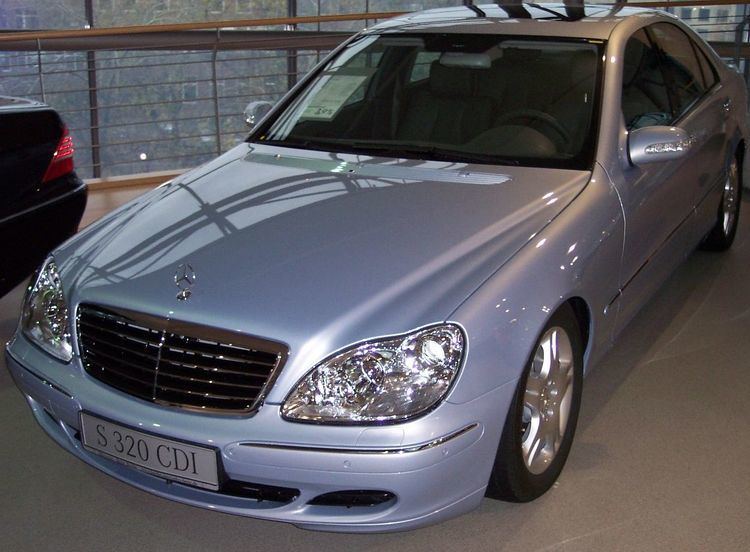 | ||
Active Body Control, or ABC, is the Mercedes-Benz brand name used to describe hydraulic fully active suspension, that allows control of the vehicle body motions and therefore virtually eliminates body roll in many driving situations including cornering, accelerating, and braking. Only available on rear-wheel drive models, all-wheel drive models are available only with Airmatic semi-active air suspension. Production version introduced at the 1999 Geneva Motor Show on the new Mercedes-Benz CL-Class C215.
Contents
Description
In the ABC system, a computer detects body movement from sensors located throughout the vehicle, and controls the action of the active suspension with the use of hydraulic servomechanisms. The hydraulic pressure to the servos is supplied by a high pressure radial piston hydraulic pump. A total of 13 sensors continually monitor body movement and vehicle level and supply the ABC controller with new data every ten milliseconds. Four level sensors, one at each wheel measure the ride level of the vehicle, three accelerometers measure the vertical body acceleration, one acceleration sensor measures the longitudinal and one sensor the transverse body acceleration. At each hydraulic cylinder, a pressure sensor monitors the hydraulic pressure. As the ABC controller receives and processes data, it operates four hydraulic servos, each mounted in series on a spring strut, beside each wheel. Almost instantaneously, the servo regulated suspension generates counter forces to body lean, dive and squat during various driving maneuvers. A suspension strut, consisting of a steel coil spring and a shock absorber are connected in parallel, as well as a hydraulically controlled adjusting cylinder, are located between the vehicle body and wheel. These components adjust the cylinder in the direction of the suspension strut, and change the suspension length. This creates a force which acts on the suspension and dampening of the vehicle in the frequency range up to five hertz.
The system also incorporates height adjustable suspension, which in this case lowers the vehicle up to 11 mm (0.43 in) between the speeds of 60–160 km/h (37–99 mph) for better aerodynamics, fuel consumption, and handling.
The ABC system also allows self-levelling suspension, which raises or lowers the vehicle in response to changing load (i.e. the loading or unloading of passengers or cargo). Each vehicle equipped with ABC has an “ABC Sport” button that allows the driver to adjust the suspension range for different driving style preferences. This feature allows the driver to adjust the suspension to maintain a more level ride in more demanding driving conditions.
The Mercedes-Benz C112 of 1991, Mercedes-Benz Vario Research Car of 1995 and the Mercedes-Benz F200 of 1996 already featured prototype versions of ABC.
The first complete and ready-for-production version of ABC was introduced in 1999 on the top-of-the-line Mercedes-Benz CL-Class
In 2010 a crosswind stabilization function was introduced. In strong gusts of crosswind, and depending on the direction and intensity of the wind having an effect on the vehicle, this system varies the wheel load distribution in such a way that the effects of winds are largely compensated or reduced to a minimum. For this purpose the ABC control unit uses the yaw rate, lateral acceleration, steering angle and road speed sensors of the Electronic Stability Program ESP®.
Magic Body Control
In 2007, the Mercedes-Benz F700 concept introduced the PRE-SCAN suspension, an early prototype road scanning suspension, using lidar sensors, based on Active Body Control.
In 2013 the new Mercedes-Benz S-Class (W222) introduced the series production version of PRE-SCAN, but with a stereo camera instead of laser projectors. The system dubbed Magic Body Control is fitted with a road-sensing system (Road Surface Scan) that pre-loads the shocks for the road surface detected. Using a stereo camera, the system scans the road surface up to 15 meters ahead of the vehicle at speeds up to 130 km/h (81 mph), and it adjusts the shock damping at each wheel to account for imperfections in the road. Initially only available on 8-cylinder models and above, Magic Ride Control attempts to isolate the car's body by predicting rather than reacting to broken pavement and speed humps. The ABC has undergone major modifications for the new S-Class: the wheel damping is now continuously adjustable, the spring strut response has been improved and the pump efficiency has been further enhanced. A digital interface connects the control unit and the sensors, while the fast FlexRay bus connects the control unit and the vehicle electronics. Processing power is more than double that of the previous system.
In 2014 the new C217 S-Class Coupe introduced an update to Magic Body Control, called Active Curve Tilting. This new system allows the vehicle to lean up to 2.5 degrees into a turn, similar to the way a motorcycle leans into a turn. The leaning is intended to counter the effect of centrifugal force on the occupants and is available only on rear-wheel drive models
Vehicles
Vehicles, chronological order:
